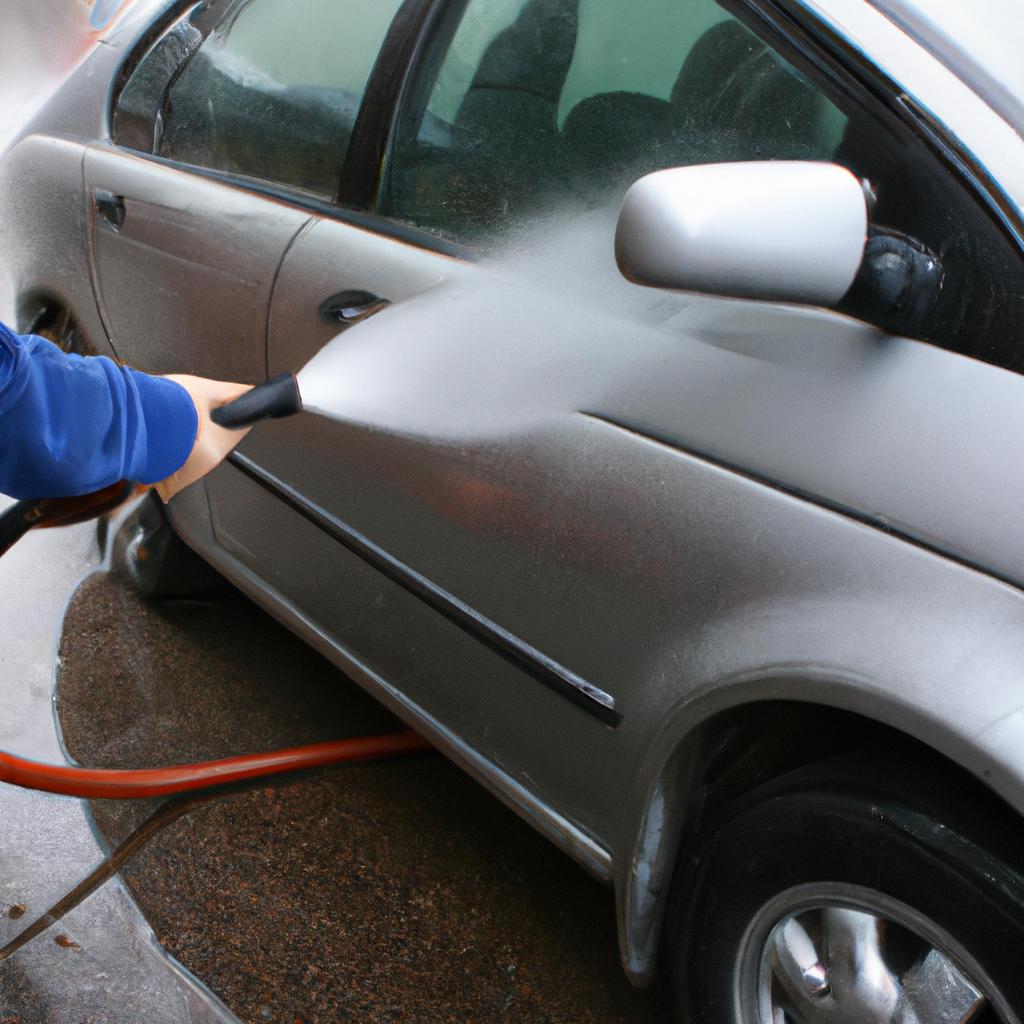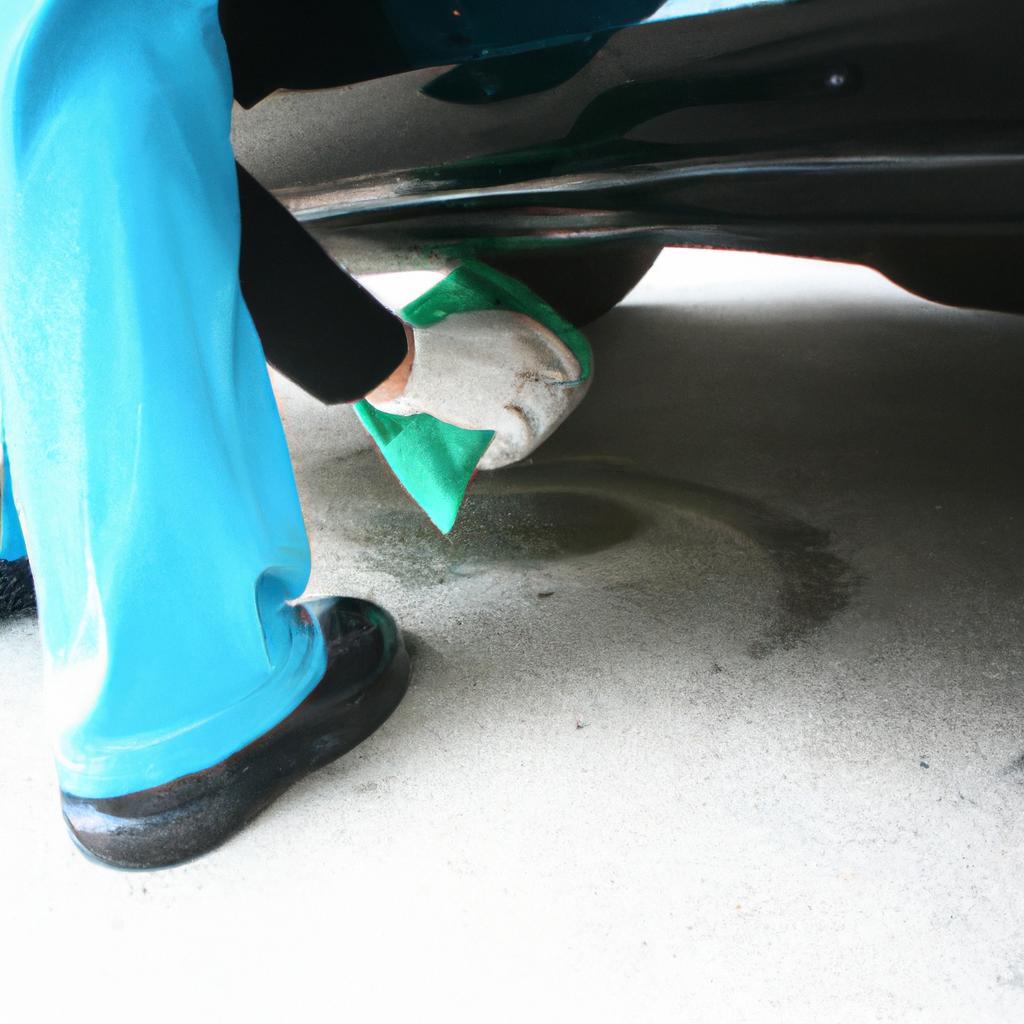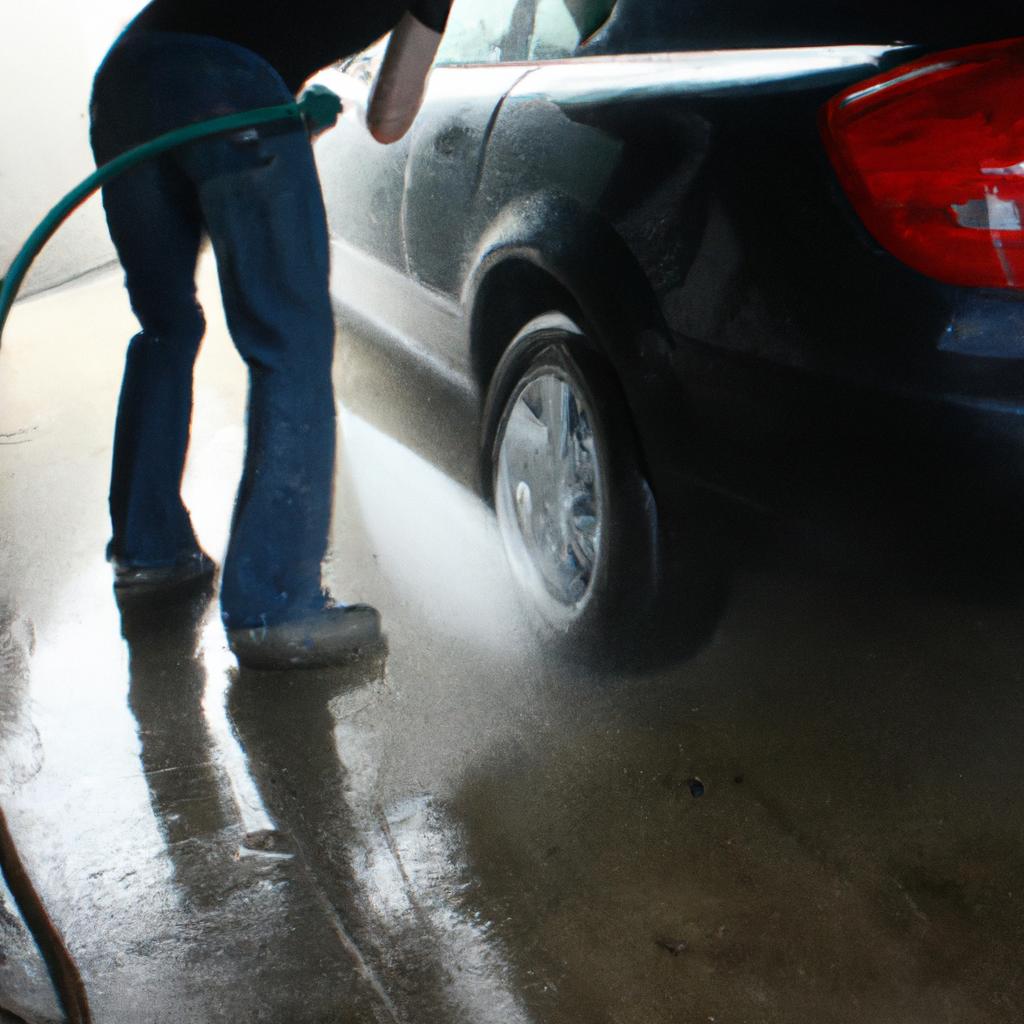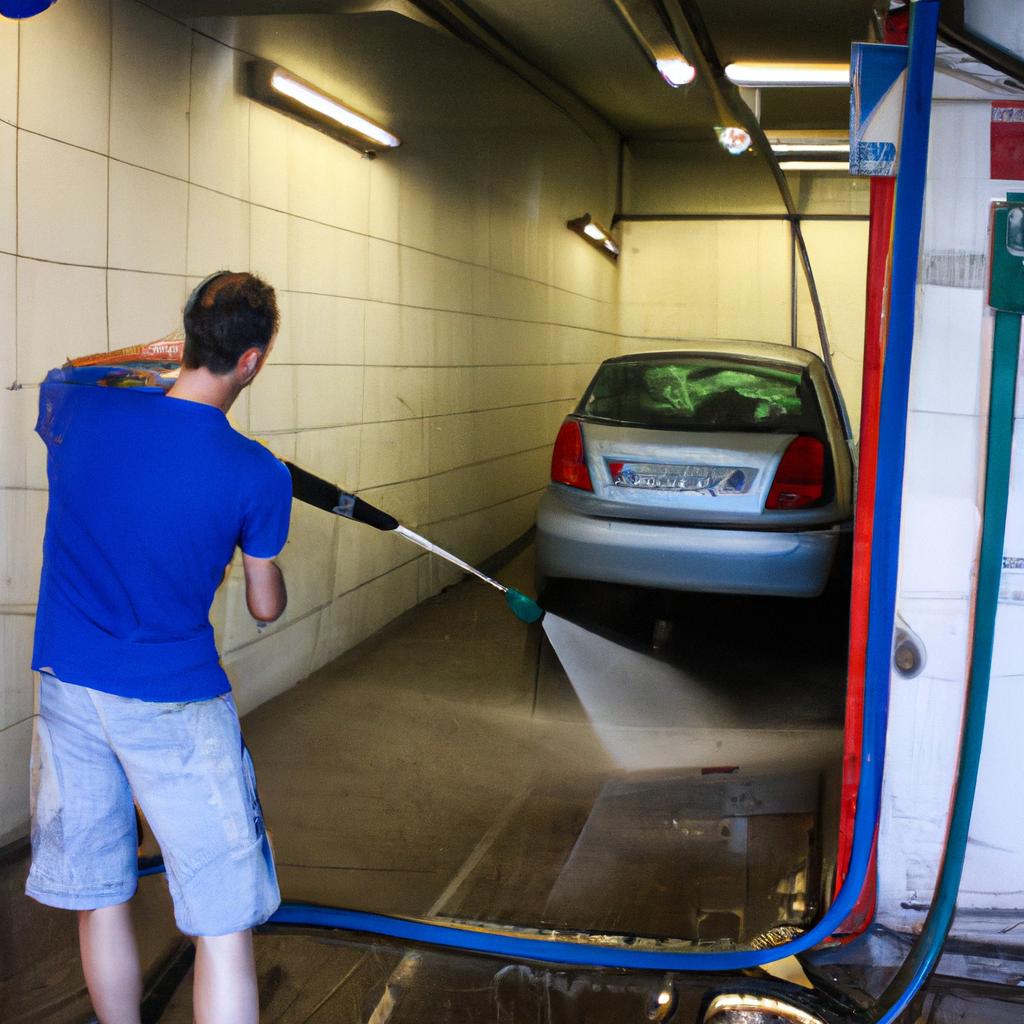Spray patterns play a crucial role in the underbody wash process in car wash facilities. The proper application of water and chemical solutions is essential to effectively remove dirt, grime, and other contaminants from the underside of vehicles. Understanding and optimizing spray patterns can lead to improved cleaning results, increased customer satisfaction, and prolonged vehicle lifespan.
For instance, consider a hypothetical scenario where a car wash facility neglects to pay attention to spray patterns during the underbody wash process. As a result, the water jets are misaligned or improperly calibrated, leading to uneven coverage on the undercarriage of each vehicle passing through the system. In this case, certain areas may receive excessive pressure while others remain untouched by the cleaning solution. This inadequate distribution not only compromises the quality of cleanliness but also increases the risk of corrosion and damage over time due to untreated debris remaining in hidden crevices. Therefore, understanding and implementing appropriate spray patterns is imperative for achieving optimal outcomes in car wash operations.
In this article, we will delve into the significance of spray patterns in underbody washing within car wash facilities. By examining various factors that influence these patterns such as nozzle design, water pressure settings, and chemistry formulation, we aim to provide insights into how operators can optimize their processes for maximum effectiveness and efficiency.
Nozzle design is a critical factor in determining the spray pattern. Different nozzle types, such as fan nozzles or rotating nozzles, produce different spray patterns that can be adjusted to cover a specific area effectively. Fan nozzles create a wide-angle spray pattern, ideal for covering larger surface areas evenly. On the other hand, rotating nozzles provide a more concentrated and powerful stream that can target specific areas requiring extra attention, such as wheel wells or heavily soiled sections.
Water pressure settings also play a significant role in achieving the desired spray pattern. Too high of water pressure can result in excessive force that may damage sensitive components or push contaminants further into crevices. Conversely, insufficient water pressure may fail to dislodge dirt effectively. Finding the optimal balance is crucial to ensure thorough cleaning without causing any harm.
Chemistry formulation is another aspect to consider when optimizing spray patterns for underbody washing. The chemical solutions used should have appropriate viscosity and foaming properties to adhere to the vehicle’s underside effectively. This allows for better contact time with contaminants and enhances their removal during rinsing.
To optimize spray patterns for underbody washing, car wash operators should regularly inspect and maintain their equipment. This includes checking for clogged or worn-out nozzles, ensuring proper alignment and calibration of jets, and monitoring water pressure levels. Regular maintenance will help prevent issues such as uneven coverage or inadequate cleaning performance.
In conclusion, understanding and optimizing spray patterns are essential in achieving effective underbody washing results in car wash facilities. By considering factors such as nozzle design, water pressure settings, and chemistry formulation, operators can enhance cleaning outcomes while prolonging the lifespan of vehicles passing through their systems. Paying attention to these details will lead to increased customer satisfaction and contribute to overall operational success in car wash businesses.
Importance of Undercarriage Cleaning
To understand the significance of undercarriage cleaning in car washes, let us consider a hypothetical scenario. Imagine a vehicle that has been driven through muddy terrain and accumulated dirt and debris underneath. Over time, if this buildup is not properly addressed, it can lead to various issues such as corrosion, rusting, and mechanical damage.
Undercarriage cleaning plays a vital role in maintaining the overall health and longevity of a vehicle. The underside of a car is often exposed to harsh elements like road salt, mud, and grime. If left unattended, these contaminants can adhere to the metal surfaces and accelerate corrosion processes. Therefore, regular underbody washes are crucial for preventing extensive damage caused by environmental factors.
To emphasize the importance further, here are some key reasons why undercarriage cleaning should be prioritized:
- Corrosion Prevention: By removing dirt and chemicals from the undersides of vehicles on a regular basis, one can significantly minimize the risk of corrosion.
- Mechanical Integrity: A clean undercarriage allows for easier inspection and maintenance of critical components such as suspension systems or exhaust parts.
- Enhanced Safety: Properly functioning brakes and steering mechanisms rely on unobstructed pathways free from excessive dirt accumulation.
- Improved Resale Value: Regular underbody washing preserves the aesthetic appeal of a vehicle’s underside, thereby increasing its resale value over time.
| Reasons for Undercarriage Cleaning |
|---|
| Corrosion Prevention |
In conclusion, keeping up with routine undercarriage cleaning is essential for both practical and financial reasons. Next, we will explore different types of spray patterns used in professional car washes without compromising effectiveness or convenience
Different Types of Spray Patterns
Now, let us explore different types of spray patterns used for underbody washes in car wash facilities.
One common type of spray pattern utilized is the fan pattern. This pattern sprays water in a wide arc, covering a larger surface area at once. It is effective in removing loose dirt and debris from the undercarriage quickly. However, this pattern may not be as efficient when it comes to tackling stubborn grime or grease buildup.
Another commonly employed spray pattern is the pinpoint jet pattern. Unlike the fan pattern, this concentrated stream of water targets specific areas with greater force. The pinpoint jet pattern is particularly useful for dislodging tougher substances stuck underneath the vehicle, such as mud or dried-on road salt.
The third type of spray pattern often used for underbody washing is the oscillating spray pattern. As its name suggests, this pattern moves back and forth horizontally while spraying water onto the undercarriage. By providing thorough coverage across all parts of the underside, including hard-to-reach nooks and crannies, the oscillating spray effectively removes dirt and grime that might otherwise go unnoticed.
To illustrate further how these different spray patterns affect customers’ experience at a car wash facility, consider this hypothetical scenario: A customer enters a car wash with their heavily soiled SUV after an off-road adventure. They opt for an underbody wash service to ensure proper cleaning of their vehicle’s undersides.
-
Upon selecting the fan spray option:
- The wider coverage helps remove large clumps of mud.
- However, some caked-on dirt remains untouched due to limited pressure exerted by the fan-like spread.
-
Switching to the pinpoint jet mode:
- The focused stream successfully blasts away most remaining dirt particles.
- Yet, some areas are challenging to reach due to the narrowness of the jet, resulting in incomplete cleaning.
-
Finally, utilizing the oscillating spray:
- The back-and-forth motion ensures comprehensive coverage.
- All remaining dirt and grime are effectively removed from every corner of the undercarriage.
In summary, car wash facilities employ various spray patterns for underbody washing, each with its own advantages. These patterns include the fan pattern for wider coverage, pinpoint jet pattern for targeted force, and oscillating spray pattern for thorough cleansing. In our subsequent section on the benefits of underbody washes, we will delve deeper into how these different spray patterns contribute to maintaining a vehicle’s health and appearance.
Benefits of Underbody Wash
Spray Patterns: Underbody Wash in Car Wash
In the previous section, we explored the various types of spray patterns commonly used in car washes. Now, let’s delve into one specific type known as underbody wash and its benefits. To illustrate its effectiveness, consider a case study of two cars that were subjected to identical road conditions: one underwent regular car washing without underbody wash, while the other received regular car washing with underbody wash.
The first noticeable difference between these two cars was their overall cleanliness. The car that only underwent regular car washing showed visible dirt and grime buildup on its undercarriage. In contrast, the car that received underbody wash exhibited a significantly cleaner underside. This highlights one of the primary benefits of underbody wash – it helps remove accumulated dirt and debris from hard-to-reach areas beneath the vehicle.
To better understand how underbody wash achieves this superior cleaning effect, let us examine some key features associated with this spray pattern:
- Enhanced pressure: Underbody wash utilizes high-pressure water jets to dislodge stubborn dirt particles.
- Wide coverage: The spray pattern is designed to cover a larger surface area, ensuring comprehensive cleaning.
- Targeted nozzle positioning: Nozzles are strategically positioned to direct water towards critical components such as suspension systems and brake lines.
- Thorough rinsing: Underbody wash ensures thorough rinsing by effectively flushing away contaminants like salt residues which can accelerate corrosion.
By incorporating these features, an efficient underbody wash system offers several advantages beyond just improved cleanliness. Let’s explore these benefits further in the next section.
Factors to Consider for Effective Cleaning
Benefits of Underbody Wash
Spray Patterns: Underbody Wash in Car Wash
Now that we have explored the benefits of underbody wash, let us delve into the factors to consider for effective cleaning. To illustrate these factors, imagine a scenario where you are driving through muddy terrains and your car’s undercarriage becomes caked with dirt and grime. In such a case, an underbody wash would be essential to remove this buildup effectively.
There are several key elements to consider when it comes to spray patterns for underbody washes:
-
Coverage: An effective underbody wash should provide comprehensive coverage across the entire underside of the vehicle. This ensures that all areas, including hard-to-reach spots like wheel wells and suspension components, receive thorough cleaning.
-
Pressure: The pressure exerted by the spray pattern is crucial in dislodging stubborn debris from the undercarriage. A high-pressure stream helps remove mud, salt, and other contaminants effectively without causing damage to delicate parts or sensitive electrical connections.
-
Angle of Attack: The angle at which the water hits the undercarriage plays a significant role in achieving optimal cleaning results. It is important to ensure that the spray reaches all nooks and crannies while avoiding excessive force on vulnerable areas or potential water ingress points.
-
Water Temperature: While not directly related to spray patterns, water temperature can enhance the effectiveness of an underbody wash. Warm water aids in breaking down grease and oil residues more efficiently, providing better overall cleaning performance.
To further emphasize these considerations visually, here is a table showcasing different types of spray patterns commonly used in car wash systems:
| Spray Pattern | Description | Benefits |
|---|---|---|
| Fan | Wide-angle coverage | Efficiently removes loose debris |
| Cone | Concentrated stream | Targets specific areas with precision |
| Arch | Overhead spray | Provides overall coverage with consistent pressure |
| Oscillating | Side-to-side motion | Ensures thorough cleaning of larger undercarriage surfaces |
Understanding and implementing these factors in your car wash system will result in an effective underbody wash that keeps your vehicle’s underside clean and well-maintained.
Moving forward, let us now explore common mistakes to avoid when performing underbody washes.
Common Mistakes to Avoid
In order to achieve effective cleaning in underbody wash, there are several factors that need to be taken into consideration. These factors play a crucial role in determining the outcome of the cleaning process and ensuring optimal results.
One important factor is the spray pattern used during the underbody wash. The spray pattern refers to the way water is distributed over the surface being cleaned. It should be designed in such a way that it covers all areas evenly and effectively removes dirt and debris. A common mistake is using a narrow or concentrated spray pattern, which may result in inadequate cleaning and leave some areas untouched.
Another factor to consider is the pressure of the water being used. The pressure needs to be high enough to remove stubborn dirt and grime, but not so high that it damages sensitive parts of the vehicle’s undercarriage. Finding the right balance is essential for achieving thorough cleaning without causing any harm.
Furthermore, the temperature of the water also plays a significant role in effective cleaning. Warm water has better cleaning properties as it helps break down grease and oil more efficiently than cold water. However, too hot water can potentially cause damage to certain components, so it is important to find an appropriate temperature range.
To summarize these factors:
- Use an appropriate spray pattern that covers all areas evenly.
- Find the right balance between water pressure for efficient cleaning without causing damage.
- Optimize water temperature by using warm water within a safe range.
By considering these factors, car wash operators can ensure that their underbody wash provides effective cleaning while minimizing potential risks or damages.
| Factors | Importance |
|---|---|
| Spray Pattern | High |
| Water Pressure | Medium |
| Water Temperature | High |
Maintenance Tips for Undercarriage
Common Mistakes to Avoid in Underbody Washing
Despite the importance of underbody washing in car maintenance, there are several common mistakes that car owners should be aware of and avoid. One such mistake is using too much pressure during the wash process. While it may seem logical to use high-pressure water to effectively clean the undercarriage, excessive force can actually damage delicate components such as sensors or wiring systems. It is crucial to strike a balance between removing dirt and debris without causing harm.
Another common mistake is neglecting to remove loose items from the undercarriage before starting the wash. These items might include road debris, fallen leaves, or even small animals seeking shelter. Failing to clear these objects beforehand could lead to clogs in the drainage system or cause further damage when they come into contact with moving parts during the wash cycle.
Furthermore, not following the recommended spray patterns for an underbody wash can result in inconsistent cleaning and potential missed spots. Depending on the design of your vehicle’s chassis, different areas may require specific attention due to variations in dirt accumulation or vulnerability to corrosion. By understanding and adhering to proper spray patterns, you will ensure thorough cleaning throughout the entire undercarriage.
To summarize, here are some key points regarding common mistakes to avoid when performing an underbody wash:
- Use appropriate water pressure: Find a balance between effective cleaning and avoiding damage.
- Clear any loose items: Remove debris or living organisms that may hinder the washing process.
- Follow recommended spray patterns: Ensure consistent coverage for optimal cleanliness.
By being mindful of these mistakes and taking necessary precautions, you can maintain a healthy undercarriage while preserving important components of your vehicle’s infrastructure.
| Common Mistake | Potential Consequences |
|---|---|
| Using excessive water pressure | Damage sensitive components |
| Neglecting loose items | Clogs in drainage system |
| Ignoring recommended sprays | Inconsistent cleaning, missed spots |
Remember, the underbody wash is an integral part of car maintenance and should not be overlooked. By avoiding these common mistakes and following recommended guidelines, you can keep your vehicle’s undercarriage in optimal condition for years to come.
 Shine Time Car Wash
Shine Time Car Wash



